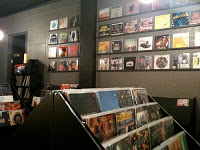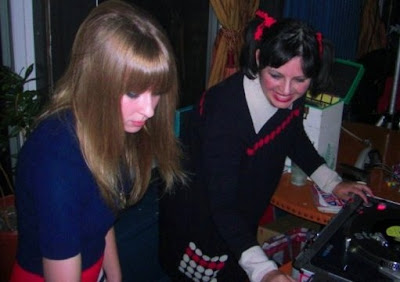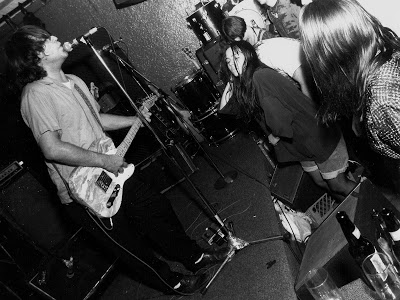At that time I certainly could not have predicted the impact on music history by the music that was being released that year and I feel fortunate to have been involved in it in any way. In 1991 I was a record clerk and indie music buyer at a small independent record store in NJ. I had graduated from high school just the year before and like anyone at that age, was impressionable and hungry to participate in something I believed in. My passion was (and still is) for all things Indie but this would be the year that major labels started to heavily troll the independent music scene to sign them. I couldn't have possibly known the music I was stocking for our store's shelves would be revolutionary in nature but as time has shown, many of the records that debuted in 1991 changed music and people's lives forever.
Here is a little look at my 1991:
I was buying music from a distributor that I would eventually work for called Caroline. They had a gaggle of debut records that we not only carried at the store but afforded me dibbs on free tickets and guest list spots to check out these new signings. Among them were Smashing Pumpkins and Hole. I had the opportunity to see both bands at Maxwell's in Hoboken, NJ which is a venue not much bigger than a two car garage. Comically just a little bit later I was pushed by a different label rep to check out the new Temple of the Dog / Mother Love Bone band called Pearl Jam who had scored the opening slot in a tour with the Pumpkins. This was in a much larger venue but the moral of this story is that the Smashing Pumpkins were not much a live band and Pearl Jam crushed them, they literally destroyed the room with them vitality. They were charismatic, energetic, and emotional in a whole new direction from Dischord's hardcore version. I was skeptical of the band at first but after that one performance they won me over and I continued to see them play in places like Wetlands in NYC before radio and MTV made the band superstars. I even had a Pearl Jam promotional door mat in front of my apartment door until they got so popular that somebody else in my building stole it. I also remember when Matt Chamberlain replaced PJ's first drummer, he was talked into making promotional phone calls to record stores to hype the release of Ten and we spent an awkward ten minutes or so talking about the band and joking with me that the band was hazing into the band by making him do all he crappy promotional junk the rest of the band wanted nothing to do with.
I prided myself on being a record store employee that didn't make people feel bad about the music they were buying but at the same time I tried to champion new music that was along the same lines of other artists a customer liked but was not as well known. By 1991 My Bloody Valentine already had an established following so while I loved Loveless, I would have never guessed that this one record would create decades on knock off versions to come. At the time, MBV fans were already so protective of the group that they called any other band with a similar sound copy cats and unfortunately a lot of incredible bands were written off because of it. The Swirlies, The Lily's, Slowdive...the list goes on and on....were all bands I loved, honestly more than I loved MBV, and to this day the disgruntled record clerk in me wants to give a speech when I hear someone paint My Bloody Valentine as the only shoegaze band that matters. I feel very fortunate to have also seen MBV play at Maxwell's before their really took off but I think the thing that amazes me the most about Loveless is that 20 years later we are STILL waiting for a follow up release.
Swervedriver released Raise in 1991. Their label's big promotional idea was to send record stores a cassette walkman and headphones with a copy of Raise sealed inside it and it remains the first and only tape listening station I have ever seen at a record store. Memory two about the band is being very disappointed with Swervedriver live. They played a big show in NYC with, let me think about this, maybe Ned's Atomic Dustbin and The Doughboys (???) and Swervedriver was sleepy and dull. Having loved their music as much as they did I was pretty crushed that live they drove into sleepytown and parked there.
Teenage Fanclub released Bandwagonesque and while at the time I thought the record was pretty good, I wasn't wild about it but I did like their promo item. Their label had made these cute hot pink promotional money bags out of balloons filled with sand (matched the cover art) and it was a cherished item displayed at the store until time had its way with it and the balloon eventually leaked sand everywhere. In 1991 record labels still had money to make promotional items and even the smallest band on a major label had some sort of kitsch item created in their name and or a massive open bar dinner meet and greet type event happening in every major city too. It boggles the mind to think of the money major labels were spending on signing bands and marketing them during this time period.
Nirvana is really worthy of a post in itself. Our NJ store was buying records from Sub Pop directly in 1988 so we were already hip to grunge and many of the bands that didn't really break into the mainstream until 1992. As a high school senior I was asked by my Sub Pop rep to see the Nirvana play at Maxwell's and make sure they had a place to stay that night. So there I was as an 18 year old living at home asking Nirvana if they had a place to crash and if not that they were welcome to stay with my family. The DIY community looks after each other this way and as crazy as it sounds now, it was the most natural thing in the world at the time.
By 1991 I was already a HUGE fan of Nirvana (but an even bigger Mudhoney fan) and was waiting with baited breath for Nevermind to come out.There were already a few tape bootlegs floating around of the demo versions of the record so I already knew the music was amazing and it felt like agony waiting for it to finally have a proper release. Their label ran a window display contest for the release and first place was a $100, a trip to Seattle for two to see Nirvana play a festival happening in our near Seattle (along with Sonic Youth, Mudhoney, and L7), meet the band, and get a tour of all the hot spots of the city. What I didn't know at the time was that many stores refused to participate in the window display contest because they were afraid the naked baby whose penis was showing on the cover art might offend some of their customers. Being a punk rock store with attitude, we didn't care. My boss gave me his blessing and in turn I created our front window to look like an aquarium or view into an ocean. I created a water line, hung fish to look like they were swimming, placed sand and coral at the bottom with a giant subway poster of the album art centered in the middle so it looked like the baby was swimming in our window. Without much competition out there from our region, we won. My boss and I went to Seattle only it turned out that the press had just gotten a hold of the news that parents to be Kurt and Courtney were using drugs and a PR nightmare began for two stars on the rise. Nirvana ended up being pulled from that festival and I didn't end up meeting with any of the members that trip. A poor label rep (who is still a friend of mine after all these years) got stuck babysitting us "winners" while in Seattle and the extra irony of this trip was nobody had ever asked my age. In Seattle you had to be 21 to go to most shows and all bars so I couldn't go very many places. In an effort to keep my trip age appropriate I toured Sub Pop, C/Z, Jack Endino's studio, a few recording studios, the Sound Garden sculpture park; all things in hindsight I feel so honored to have seen in person as a 19 year old. While Nirvana's Nevermind became an angsty anthem to a whole generation, they opened the door to Seattle for me and it was this trip that inspired me to eventually move there a few years later and work at C/Z records.
At this point in my life I wasn't completely sold on Beat Happening. My Sub Pop sales rep pushed them on me but it wasn't until I saw them open for Fugazi (once again at Maxell's + Steady Diet of Nothing came out that year too!) that I finally appreciated the band for all their cockeyed charm. Years later when I worked for C/Z and had to call K Records who is owned by Calvin from Beat Happening, a co-worker played a pretty amazing prank on me. He told me that Calvin's real voice wasn't really that deep and that he only used that voice for the band and to mess with people he didn't like. Since I was basically a kid freshly imported from NJ I had no idea that this wasn't true. He seemed like a pretty oddball guy so it wasn't totally impossible to me. I called K Records that day and was devastated that Calvin only spoke to me with a baritone rumble. As soon as I hung up the phone my co-worker asked me how it went and being new at the job and already feeling overwhelmed, I was teary when I told him he used his funny voice with me. The whole office burst into laughter at this report and that was the moment I learned that there was only one Calvin voice and it is always sounds deep and devilish.
While some bands were just hitting their peak of popularity with the masses, for those of us embedded in the indie scene, many of the hot bands were old news and no longer of major consequence to us. Babes in Toyland, Sonic Youth, Pixies, Soundgarden, Screaming Trees, and Mudhoney were among the list of artists who out records that year and at the top of my over it list was Dinosaur Jr. By 1992 I had moved onto other bands and I almost feel guilty confessing my lack of interest in these classic bands by this time. Most of the world was just discovering these bands and their music but for an elite group of us, these bands were old news and their records didn't alter our world or even add a ripple to it.I spent a good deal of time from 1988 to 1991 seeing these artists play tiny backroom spaces and like many fans who loose their favorite band to the masses when they become popular, I found up and coming bands that still offered an intimate live experience and were easily accessible via letter or in person at their shows. I can't explain why contact with these bands were so important then but I think at the core of this phenomena was that we were all in it together. They weren't stars and we weren't just fans; we were equals. There was an energy exchange shared at live shows. We were our own weird dysfunctional little country with a culture onto itself.
There were a whole new army of bands that had captured my attention and Superchunk and Seaweed are perfect examples of where my interest was turning towards. Both had released new albums that year (No Pocky / Despised, had toured together and represented a new breed of heavy bands that also carried a melody. I was so carried away with Seaweed that I took the time to write them fan letters (which for that time period was also a norm in the DIY world) and this began a pen pal relationship with the band. By Seaweed's second or third tour we were friends and most of the band stayed with me whenever they came to NJ or NYC. They were among some of the first bands to ever stay with me and 1991 became the year I started housing bands regularly. Failure, Treepeople, Archers of Loaf, Jawbox (whose debut came out in 1991 too), Peechees, Jessamine, Karp, Fitz of Depression, Pegboy, Small 23, Red Stars Theory, Heavy Vegetable, Superconductor; there are actually too many to list or recall! I can't tell you how happy I am to hear that Seaweed will be playing a one off reunion show in NYC next month and in case it wasn't obvious, hell yeah I will be there!
While Sonic Youth did not release a record this year, they were busy touring for Goo and their European tour became the meat for the documentary called "The Year Punk Broke" that also included many of the bands I have written about here like Nirvana and Babes in Toyland. It was this movie that forever dubbed 1991 "The Year Punk Broke" and it is this VHS that has inspired me to revisit the theme twenty years later for Cause & Effect. By the end of 1991 the whole world knew about these bands that up until these artists had lived in the shadow of popular culture - not the spotlight. It was a pivotal time for music but for me too as I grew from kid to adult. So as it turns out, 1991 was an off the charts momentous time in my life too. I look forward to playing two hours of music from this year tonight and sharing some more stories about these records.
Tune in from 7PM to 9PM on WRIR at 97.3fm on your dial here in Richmond or stream the show live at www.wrir.org where you will also see the set list as the night progresses.
UPDATE: Download the full radio show here.
Here is the link to the set list.






